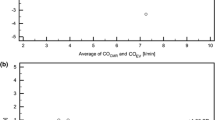Abstract
Objective. The objective of our study was to evaluate impedance cardiography (IMP) as a noninvasive method to determine the left ventricular ejection fraction (LVEF).Methods. A total of 24 patients, 8 men and 16 women, aged 45.0 ± 12.9 years, participated in the study. They used cardiotoxic chemotherapeutic drugs or suffered from cardiac failure. LVEF was measured by means of IMP (LVEFimp) and radionuclide ventriculography (LVEFnuc). LVEFimp was calculated in three ways. Capan and colleagues [13] proposed a formula in which LVEF (LVEFCap) can be calculated from the systolic time intervals, namely, left ventricular ejection time and preejection time. Judy and colleagues [14] described a systolic (S) and a diastolic (D) part in the first derivative curve of the impedance signal. The ratio S/D might equal the LVEF (LVEFJud). A new LVEF calculation was introduced (LVEFimp) in this study based on the first derivative of the impedance signal, the thoracic impedance, and heart rate.Results. Mean LVEFCap was 59.9 ± 8.4%, which did not differ from LVEFnuc (59.9 ± 7.1%). However the correlation between both methods was not significant (γ = 0.29). Mean LVEFJud was 63.9 ± 17.4%, which was not significantly different from LVEFnuc, with a fair correlation (γ = 0.55). Mean LVEFimp was 59.2 ± 9.4%, with a better correlation with radionuclide ventriculography (γ = 0.75).Conclusions. The results of this study indicate that the equations that have been used until now can be improved. The new equation provides reliable LVEF values in this group of patients.
Similar content being viewed by others
References
Rocco TP, Dilsizian V, Fischman AJ, Strauss W. Evaluation of ventricular function in patients with coronary artery disease. J Nucl Med 1989;30:1149–1165
Hoilund-Carlsen PF, Lauritzen SL, Marving J, et al. The reliability of measuring left ventricular ejection fraction by radionuclide cardiography: Evaluation by the method of variance components. Br Heart J 1988;59:653–662
Verani MS, Gaete J, LeBlanc AD, et al. Validation of left ventricular volume measurements by radionuclide angiography. J Nucl Med 1985;26:1394–1401
Hains AD, Khawaja IA, Hinge DA, et al. Radionuclide left ventricular ejection fraction: A comparison of three methods. Br Heart J 1987;57:232–236
Thorley PJ, Sheard KL, Rees MR. A comparison of methods for estimating left ventricular volumes from radionuclide ventriculography. Physiol Meas 1993;14:23–32
Thomas SHL, Cooper RC, Ekwuru M, et al. Differential cardiovascular effects of propanolol, atenolol, and pindolol measured by impedance cardiography. Eur J Clin Pharmacol 1992;42:47–53
Dalal S, Yu AW, Gupta DK, et al. L-Lactate high efficiency hemodialysis: Hemodynamics, bloodgas changes, potassium/phosphorus, and symptoms. Kidney Int 1990;38:896–903
Edmunds AT, Godfrey S, Tooley M. Cardiac output measured by transthoracic impedance cardiography at rest, during exercise and at various lung volumes. Clin Sci 1982;63:107–113
Appel PL, Kram HB, Mackabee J, et al. Comparison of cardiac output by bioimpedance and thermodilution in severely ill surgical patients. Crit Care Med 1986;14:933–935
Spinale FG, Smith AC, Crawford FA. Relationship of bioimpedance to thermodilution and echo cardiographic measurements of cardiac function. Crit Care Med 1990;18:414–418
Young JD, McQuillan P. Comparison of thoracic electrical bioimpedance and thermodilution for the measurement of cardiac index in patients with severe sepsis. Br J Anaesth 1993;70:58–62
Garrard CL, Weissler A, Dodge HT. The relationship of systolic time intervals to ejection fraction in patients with cardiac disease. Circulation 1970;42:455–462
Capan LM, Bernstein DP, Patel KP, et al. Measurement of ejection fraction by a bioimpedance method (Abstract). Crit Care Med 1987;15:402
Judy WV, Hall JH, Elliot WC. Left ventricular ejection fraction measured by the impedance cardiographic method (Abstract). Fed Proc 1983;41:1006
Bernstein DP. A new stroke volume equation for thoracic electrical bioimpedance: Theory and rationale. Crit Care Med 1986;14:904–909
Sramek BB, Rose DM, Miyamoto A. Stroke volume equation with a linear base impedance model and its accuracy as compared to thermodilution and magnetic flow meter techniques in humans and animals. Proceedings of the Sixth International Conference on Electrical Bioimpedance (Abstract). Zadar, Yugoslavia: 1983:38
Miles DS, Gotshall RW, Quinones JD, et al. Impedance cardiography fails to measure accurately left ventricular ejection fraction. Crit Care Med 1990;18:221–228
Graige G. Systolic time intervals. In: Braunwald E, ed. Heart disease. Philadelphia: WB Saunders, 1988:54–55
Bland JM, Altman DG. Statistical methods for assessing agreement between two methods of clinical measurement. Lancet 1986;1:307–310
Sherwood A, Allen MT, Fahrenberg J, et al. Methodological guidelines for impedance cardiography. Psychophysiology 1990;27:1–23
Sherwood A, Carter LS, Murphy CA. Cardiac output by impedance cardiography: Two alternative methodologies compared with thermodilution. Aviat Space Environ Med 1991;62:116–122.
Author information
Authors and Affiliations
Rights and permissions
About this article
Cite this article
van der Meer, N.J.M., Oomen, M.W.N., Vonk Noordegraaf, A. et al. Does impedance cardiography reliably estimate left ventricular ejection fraction?. J Clin Monitor Comput 12, 5–9 (1996). https://doi.org/10.1007/BF02025304
Received:
Revised:
Accepted:
Issue Date:
DOI: https://doi.org/10.1007/BF02025304




